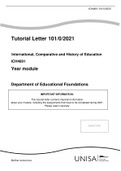RESISTANCE EXERCISE
Chapter 2
,Contents
Skeletal musculature.............................................................................................................................................................2
Info:................................................................................................................................................................................... 2
Levers of the Musculoskeletal System...............................................................................................................................2
Variations in Tendon Insertion..........................................................................................................................................5
Anatomical Planes and Major Body Movements...................................................................................................................6
Human strength and power................................................................................................................................................10
Basic Definitions..............................................................................................................................................................10
Positive Work and Power............................................................................................................................................10
Negative work and power...........................................................................................................................................11
Angular Work and Power............................................................................................................................................12
Strength versus Power.................................................................................................................................................12
Biomechanical Factors in Human Strength......................................................................................................................13
Neural Control.............................................................................................................................................................13
Muscle Cross-Sectional Area.......................................................................................................................................13
Arrangement of Muscle Fibers....................................................................................................................................13
Muscle length..............................................................................................................................................................14
Joint Angle................................................................................................................................................................... 14
Muscle Contraction Velocity........................................................................................................................................14
Joint Angle Velocity.....................................................................................................................................................15
Strength-to-Mass Ration.............................................................................................................................................15
Body Size..................................................................................................................................................................... 15
Sources of Resistance to Muscle Contraction......................................................................................................................16
Gravity............................................................................................................................................................................. 16
Applications to resistance training:.............................................................................................................................16
Weight-Stack Machines...............................................................................................................................................16
Inertia.............................................................................................................................................................................. 17
Friction............................................................................................................................................................................ 17
Fluid Resistance...............................................................................................................................................................18
Elasticity.......................................................................................................................................................................... 18
Joint Biomechanics: Concerns in Resistance Training..........................................................................................................19
Back:................................................................................................................................................................................ 19
Back Injury................................................................................................................................................................... 19
Intra-Abdominal Pressure and Lifting Belts.................................................................................................................20
Shoulders......................................................................................................................................................................... 20
Knees............................................................................................................................................................................... 20
, Elbows and Wrists...........................................................................................................................................................21
Skeletal musculature
Info:
To cause movement or to generate force against external objects, both ends of each skeletal muscle must be
attached to bone by connective tissue
o Origin= proximal attachment
o Insertion = distal attachment
o Origin = more stationary structure to which the muscle is attached
o Insertion = more mobile structure to which the muscle is attached
o Can cause confusion… traditional = more consistency
Muscle attachments:
o Fleshy attachments= found in proximal end, muscle fibers are directly affixed to bone, usually over wide
area so that force is distributed rather than localized
o Fibrous attachments = (tendons), blend into + are continuous with both muscle sheaths and connective
tissue surrounding bone. Additional fibers extend into bone to make for stronger union
Virtually all movement involves action of more than one muscle:
o Agonist= muscle most directly involved in bringing about movement (prime mover)
o Antagonist= muscle that can slow down or stop movement
o Antagonist, assists in joint stabilization + braking limb toward end of fast movement , protecting
ligaments + cartilaginous joint
o Synergist = when muscle assists indirectly in movement, also required to control body movement when
agonist is a muscle that crosses two joints
Levers of the Musculoskeletal System
Body movements directly involved in sport + exercise primarily act through levers of the skeleton
1. First-class lever:
o Lever for which the muscle force and resistive force act on opposite sides of the fulcrum
Fulcrum:
o Pivot point of a lever
Lever:
o Rigid or semi rigid body that, when subjected to a force whose line of action does not pass through its
pivot point, exerts force on any object impeding its tendency to rotate
Mechanical advantage:
o Ratio of the moment arm through which an applied force acts to that through which a resistive force
acts
o For there to be a state of equilibrium between the applied force and resistive torques, the product of
the muscle force and arm through which it acts must equal the product of the restive force and the
moment arm through which it acts.
o A mechanical advantage, represented as a ratio greater than 1.0, allows the applied (muscle) force to be
less than the resistive force to produce an equal amount of torque
o Mechanical advantage of a ratio less than 1.0 indicates that one must apply greater (muscle) force than
the amount of resistive force present, creating a disadvantage for the muscle
Moment arm:
o Perpendicular distance from the line of action of the force to the fulcrum.



